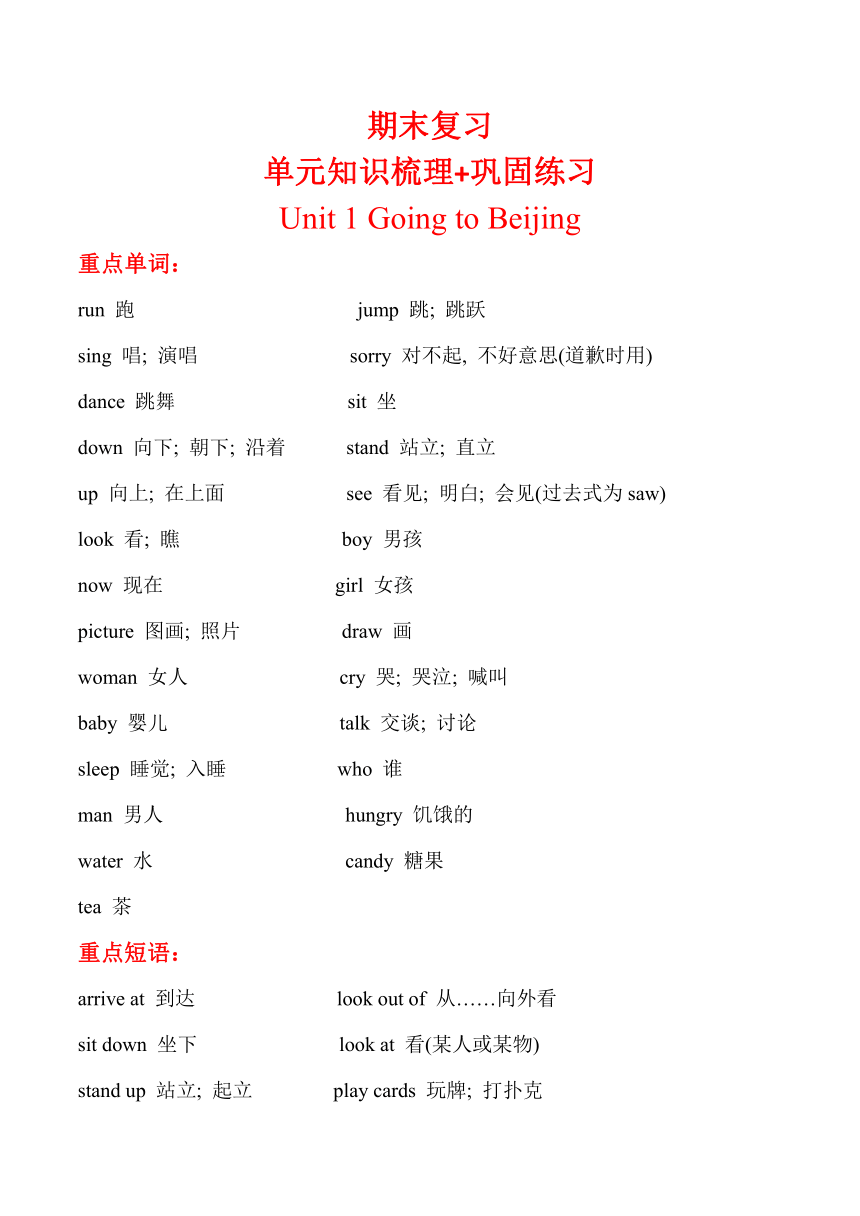
期末复习 单元知识梳理+巩固练习 Unit 1 Going to Beijing 重点单词: run 跑 jump 跳; 跳跃 sing 唱; 演唱 sorry 对不起, 不好意思(道歉时用) dance 跳舞 sit 坐 down 向下; 朝下; 沿着 stand 站立; 直立 up 向上; 在上面 see 看见; 明白; 会见(过去式为saw) look 看; 瞧 boy 男孩 now 现在 girl 女孩 picture 图画; 照片 draw 画 woman 女人 cry 哭; 哭泣; 喊叫 baby 婴儿 talk 交谈; 讨论 sleep 睡觉; 入睡 who 谁 man 男人 hungry 饥饿的 water 水 candy 糖果 tea 茶 重点短语: arrive at 到达 look out of 从……向外看 sit down 坐下 look at 看(某人或某物) stand up 站立; 起立 play cards 玩牌; 打扑克 draw a picture 画画 talk to sb. 和某人聊天 read a book 看书 play with... 和……玩 sing a song 唱歌 have fun 玩得高兴 some water 一些水 very much 很; 非常 重点句型: —What are you doing —I’m reading a book. —你正在做什么 —我正在看书。 2.Please don’t sit down. 请不要坐下。 3.—Is Jenny drawing a picture —Yes, she is. —詹妮正在画画吗 —是的, 她正在画画。 4.Who is talking 谁在说话 5.—Would you like some fruit —Yes, please./No, thanks. —你想要些水果吗 —是的, 请给我一些。/ 不了, 谢谢。 —May I play with the baby —Sure. —我可以和婴儿玩吗 —当然可以。 7.—What are you doing —I am drawing a picture. —你正在做什么? —我正在画画。 8.Jenny is looking out of the window on the train. 詹妮正在火车上向窗外看。 9.Some boys and girls are playing there. 一些男孩和女孩正在那里玩。 10. Danny is talking to the man behind you. 丹尼正在和你后面的男人交谈。 11.—Would you like some fruit —No, thanks . I’d like some tea —你想要一些水果吗?—不了,谢谢。我想要一些茶。 12.—What is that baby doing now —They are having fun. —那个婴儿现在正在做什么? —他们正玩得开心。 句型解析: 1.如何表达命令、请求、劝告、警告、禁止等含义 (1) Please don’t sit down. 请不要坐下。 (2) Please stand up. 请站起来。 解析 祈使句是用于表达命令、请求、劝告、警告、禁止等含义的句子。常见的祈使句结构: 肯定结构 否定结构 Be 型 Be+ 形容词(+ 其他) . Don’t be+ 形容词(+ 其他) Let 型 Let+ 人称代词的宾格形式+ 动词原形(+ 其他) . Let+ 人称代词的宾格形式+not+ 动词原形(+ 其他) . Don’t + let + 人称代词的宾格形式+ 动词原形(+ 其他) . Do 型 动词原形(+ 其他) . Don’t + 动词原形(+ 其他) 典例 (1) Be quiet, boys and girls! 孩子们, 安静! (2) Walk to school, please. 请步行上学。 (3) Let me help you. 让我来帮你吧。 2.询问对方正在做什么及其回答 —Jenny, what are you doing now —I am drawing a picture. —詹妮, 你现在正在干什么 —我正在画一幅画。 解析: 问句是询问对方正在做什么事情, 回答用现在进行时。现在进行时表示现在进行的动作或存在的状态。现在进行时表示动作发生的时间是“现在”, 动作目前的状态是“正在进行中”。 句型结构:—What+be 动词+ 主语+ 动词的-ing 形式(+ 其他) —主语+be 动词+ 动词的-ing 形式(+ 其他) . 动词的-ing 形式的变化规则: (1) 一般情况下在动词后直接加-ing:think—thinking sleep—sleeping (2) 以不发音的字母e 结尾的动词, 去掉e 再加-ing:make—making wake—waking (3) 以重读闭音节结尾的动词, 且末尾只有一个辅音字母, 双写末尾的辅音字母再加-ing:stop—stopping sit—sitting (4) 以ie 结尾的动词, 把ie 改为y 再加-ing:lie—lying die—dying ... ...
~~ 您好,已阅读到文档的结尾了 ~~